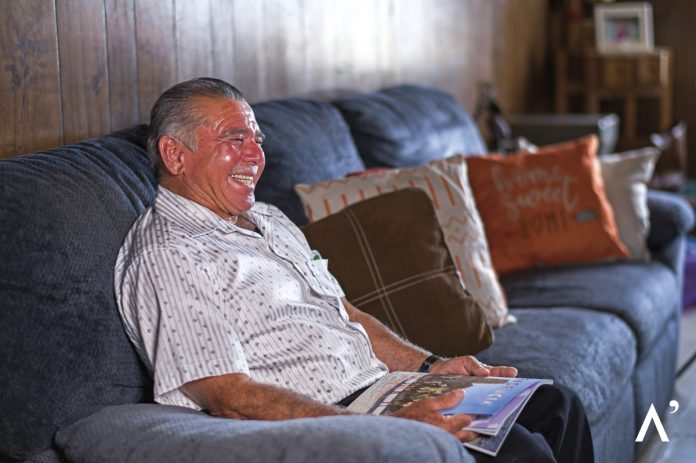“The sea must be cared for in order to be productive rather than overexploited.”
Around 1930, Cipriano’s grandfather arrived at the location when it was simply a pathway to San Ignacio. Gradually, tourists started to stay, drawn by a freshwater stream. Cipriano’s grandfather was one of the initial settlers involved in lobster fishing, which was sold to Japanese and American ships, along with clams also traded in the area. “Japanese boats and divers came to search for abalone,” he recalls. Thus, the colony of Estero de la Bocana began to take shape, with the first settlers living in Japanese-style houses surrounded by the turquoise sea, leading a challenging yet tranquil life.
“Even though these places are so old, and that the products have been exploited, they are not really known, but you live very comfortably, it is tranquil, you live happily and wonderfully, there is a lot of family harmony,” he says.
Cipriano Murillo Liera has lived in Estero de la Bocana for 67 years. He arrived at the age of 2 and had to grow up in a completely undeveloped area. It was a thoroughly virgin place. With the other local children, he used to run to the seashore to collect sargassum to make mattresses to sleep on. “I remember when I was a kid, my dad’s little house was just one big room, and we didn’t have a bed; we didn’t have anything,” he says.
Back then, the world of diving was a thrilling adventure, with scuba divers leading the way. They would journey from Ensenada to dive for abalone, a daring pursuit. By the early 1970s, the abalone packing plant was established, and only a handful of Japanese divers remained; everything was now produced locally, marking a significant shift in the diving landscape.
“At 11 years old, I worked with my dad because there were no schooling options beyond 4th grade. I repeated three times, hoping that a full elementary school would open, but it never happened. By the age of 13, I became the captain of a team and worked for two years. I had people coming from San Ignacio to work with me. However, at the age of 15, I developed a passion for diving. So, I started working as a frog diver, which we called “the suit”. I made a custom-made suit, cutting it out and gluing it on,” he says.
In the mid-1980s, as the world of fishing cooperatives began to take shape, Cipriano was at the forefront, joining the administration of the So-ciedad Cooperativa Progreso. “I had the privilege of being part of the estab-lishment of the pension and retirement fund, a significant milestone. In ’89, I was honored to be appointed President once again, a role I held with pride and dedication, marking my second term as President of the coopera-tive,” he reflects, a testament to his leadership and commitment.
And what else can you tell us about your life at Estero de la Bocana?
I don’t regret living here; I have lived happily. I have achieved many things, especially a beautiful and close-knit family. I also participated in the administration of the cooperative with some achievements that left a mark. Everything I had to live as part of society, I lived with love, dedication, and respect for myself and others. But above all, respect for the sea because it has given us so much.















